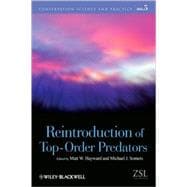
Note: Supplemental materials are not guaranteed with Rental or Used book purchases.
Purchase Benefits
Looking to rent a book? Rent Reintroduction of Top-order Predators [ISBN: 9781405192736] for the semester, quarter, and short term or search our site for other textbooks by Hayward, Matt W.; Somers, Michael. Renting a textbook can save you up to 90% from the cost of buying.
| Contributors | p. x |
| Foreword | p. xiii |
| Acknowledgements | p. xvi |
| Reintroduction of Top-Order Predators: Using Science to Restore One of the Drivers of Biodiversity | p. 1 |
| A Critical Assessment of South Africa's Managed Metapopulation Recovery Strategy for African Wild Dogs | p. 10 |
| Reintroduction Decisions Taken at the Incorrect Social Scale Devalue their Conservation Contribution: The African Lion in South Africa | p. 43 |
| Recovery of Eurasian Lynx in Europe: What Part has Reintroduction Played? | p. 72 |
| Reintroduction of Wolves to Yellowstone National Park: History, Values and Ecosystem Restoration | p. 92 |
| Aspects and Implications of Bear Reintroduction | p. 126 |
| Tiger Reintroduction in India: Conservation Tool or Costly Dream? | p. 146 |
| Snow Leopards: Is Reintroduction the Best Option? | p. 164 |
| The Suitability of the Jaguar (Panthera onca) for Reintroduction | p. 187 |
| The Status and Conservation of Leopards and Other Large Carnivores in the Congo Basin, and the Potential Role of Reintroduction | p. 206 |
| Reintroducing the Dingo: Can Australia's Conservation Wastelands be Restored? | p. 238 |
| The Role of Social Behaviour in Carnivore Reintroductions | p. 270 |
| Survival of Cheetahs Relocated from Ranchland to Fenced Protected Areas in South Africa | p. 282 |
| A Framework for Evaluating Reintroduction Success in Carnivores: Lessons from African Wild Dogs | p. 307 |
| A Synthesis of Early Indicators of the Drivers of Predator Conservation on Private Lands in South Africa | p. 321 |
| Moving Beyond the Descriptive: Predicting the Responses of Top-Order Predators to Reintroduction | p. 345 |
| Genetic Considerations in Reintroduction Programmes for Top-Order, Terrestrial Predators | p. 371 |
| Breeding Far Eastern Leopards for Reintroduction: The Zoo Programme Perspective | p. 388 |
| Lessons Learnt and Plans Laid: Seven Awkward Questions for the Future of Reintroductions | p. 411 |
| Index | p. 449 |
| Table of Contents provided by Ingram. All Rights Reserved. |
The New copy of this book will include any supplemental materials advertised. Please check the title of the book to determine if it should include any access cards, study guides, lab manuals, CDs, etc.
The Used, Rental and eBook copies of this book are not guaranteed to include any supplemental materials. Typically, only the book itself is included. This is true even if the title states it includes any access cards, study guides, lab manuals, CDs, etc.